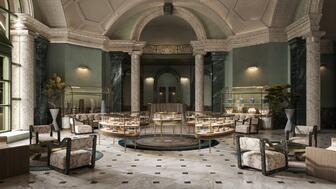Consumers shared concerns about prices, inflation, tariffs, trade, and politics in the survey’s write-in response section.
Designer’s Diary: 5 Keys to Unlocking Your Inner Artist
Vittoria d’Aste-Surcouf shares lessons about lighting, texture and storytelling from her former life in the world of contemporary art.

Well hello there! It’s been a minute since my last column. Like the rest of the world, I too am slowly emerging into this brave new world we all occupy.
It has been a difficult time, to say the least, but out of chaos and calamity can come artistic flow and abundance.
Jewelry is an art form, and it helps to approach it in the same way a visual artist approaches a painting or a sculpture, or a chef an exotic dish.
It is not surprising I think this way since my previous life (as in pre-jewelry) was spent entrenched in the New York City contemporary art world, where I earned a master’s in art history.
My days were spent in museums, galleries and artists’ studios analyzing, dissecting and deconstructing the composition, materials and style approach used by professional painters, sculptors and photographers.
As I left the art world behind and moved into creating my own jewelry art, it was only natural that I would approach jewelry design with the same classically trained artistic eye.
So, what are these techniques and principles found in fine art, and how do we apply them to the miniature sculptures called jewelry?
Below, I’ve outlined five key ways to help you channel your inner Picasso!
1. Light It Up
Drama always reigns supreme, and there is zero drama without proper lighting.
Cue the “Mona Lisa” by Leonardo da Vinci.
Although admittedly one of my least favorite paintings, I cannot argue the brilliance of the subject front and center and lit up against a darker background.
A jewelry comparison is a glorious rare diamond perfectly perched atop a ring allowing light to bounce in and out of it, creating a dazzling display.
Like the Mona Lisa, the diamond as subject matter is in the foreground, blinding you, evoking all kinds of emotions. The mounting is the background, and it becomes secondary. If this same diamond were placed too low, then the light would be diminished and the effect would not be as powerful.
Since jewelry is sculptural, the negative and positive spaces create interesting plays of light.
For example, an organic shape has smooth edges (more positive space than
When creating a more modern or edgy piece, sharp angles create starker contrasts and shadows give the piece a more angled, contrasting look.
Also, give some thought as to how the gemstone will look during different times of day or in different light—bright sunshine, the light cast by candles during a romantic dinner, everyday interior light, etc.
2. Consider Composition
So, you’ve developed your concept, you’ve roughly sketched it out and now you want to bring it to life. This is the pinnacle moment where you distinguish yourself as a designer who has learned to truly use and manipulate the medium and is seen as a master of their craft.
It is at this point you use the various elements to focus the viewer, manipulate their emotional response, determine a focal point and create harmony within your design.
It is not easy to arrange elements in a two-dimensional space (initial rendering on paper) and transfer them to a three-dimensional one.

Formal bench training helps tremendously with this because you now have a jeweler’s technical know-how.
Composition is the structure, the bones and the foundation behind the work of art.
You have set your stage, and there can only be one star of the show. It is your job as a designer to guide your audience to that focal point and make sure all the other elements are providing excellent supporting roles.
This is where the artist crosses from the creative into the technical realm.
3. Romancing Color
Jewelry is emotional and so is color. Artists use basic color theory to experiment in their works to express an emotion or mood.
Famed Impressionist painter Claude Monet used color theory beautifully in his various “Haystacks” series.
He explored the exact same theme in different light, at different times of day and during different seasons.

Each of these paintings conveyed different emotions and told a completely different narrative through color, all while using the exact same image.
At the heart of color theory is the color wheel. I have one printed and hanging in my studio so I can easily use it as a reference when working with gemstones or different metals.

Using a color wheel has many different facets, but for the sake of keeping things simple, you can begin by referencing complementary colors (directly opposite from each other on the color wheel) or analogous colors (three colors placed side by side on the color wheel).
I use this as a starting point when deciding on my gemstone palette and then I let my creativity guide me.
The Victorians were excellent at conveying mood using color when designing their mourning jewelry.
Black, brown, gray and white were the go-to colors since these hues are associated with mourning the death of a loved one.
4. Material and Surfaces
Jewelry is tactile, and we are tactile creatures. A piece can look good but if it does not “feel” good all your design efforts have been in vain.
Material choice blends the senses by appealing to our sense of touch as well as the visual. Like sculpture, jewelry has been formed by an artisan’s hand.
In fine art, there is a lot of talk about surfaces. The use of specific materials lends itself to certain manipulation that is both aesthetically pleasing and satisfies our tactile senses.
By selecting the right material, be it gold, platinum or some other kind of interesting metal, achieving the proper weight and balance is crucial. A piece that is too heavy will be uncomfortable to wear.

Surface manipulation through engraving or finishing of the metal can add an interesting effect.
To really see the details of this type of surface, you can view the piece in what is called raking light. This is an art term that means illuminating the object’s surface from almost a parallel angel and revealing information about the surface topography.
By using this technique on the surface of jewelry you are ensuring the consistency of the craftsmanship as well as your aesthetic message. Surface manipulation can include different types of engraving or enameling.
“Every piece of art has a story. Jewelry is no different, and the storytelling aspects of jewelry are even stronger because it is highly personalized.”
Who doesn’t love a good story?
We are as fascinated with the backstory of a piece of art as we are with the finished product.
Every piece of art has a story of how the artist came up with the concept, executed the process, chose their materials, colors and composition, as well how the piece finally came to be.
Jewelry is no different, and the storytelling aspects of jewelry are even stronger because it is highly personalized.
We are natural-born storytellers, so adding a bit of backstory into a piece makes the wearer and the audience connect more with the design.
In terms of design, keeping with the initial story you want to tell as a designer helps unify the concept from start to finish.
It surrounds the piece with a certain mystique, allowing the wearer to delight in it and making it invaluable to them.
The Latest

In February 2026, the auction house will move its headquarters to the former Steinway Hall, a neoclassical landmark on Billionaires’ Row.

The new show will take place Jan. 23-25, 2026.

How Jewelers of America’s 20 Under 40 are leading to ensure a brighter future for the jewelry industry.

The former BHP Billiton leader and Gemfields chairman is remembered for his influential leadership throughout his 50-year mining career.


The LVMH-owned brand has partnered with the costume design union to revamp its award for 2026.

The luxury titan inked a deal to acquire an initial minority stake in the jewelry manufacturer with a pathway to full ownership by 2032.

Roseco’s 704-page catalog showcases new lab-grown diamonds, findings, tools & more—available in print or interactive digital editions.

The company’s curation of unsigned vintage and estate jewelry debuted at the Bloomingdale’s in Costa Mesa, California.

In the recent multi-shipment seizure, CBP also found counterfeit Audemars Piguet, Moncler, and Chrome Hearts items.

Helzberg’s Chief Retail Officer Mitch Maggart shared details about its tests of a new store concept rooted in an elevated luxury experience.

Jewelers of America execs and National Jeweler editors discuss tariffs, the sky-high gold price, and the engagement that broke the internet.

The luxury goods company said founder Ippolita Rostagno will remain at the brand’s helm.

Laura Burdese, who joined the Italian luxury brand in 2022, will take on the role in July.

The National Jeweler editors revisit the most noteworthy industry happenings and design trends from 2025.

Need a gift for the cat lover who has everything? Look no further than our latest Piece of the Week.

It purchased the “Grosse Pièce,” an ultra-complicated Audemars Piguet pocket watch from the ‘20s, for a record-breaking price at Sotheby’s.

The lab-grown diamond grower now offers custom engagement and fashion jewelry through its Kira Custom Lab Jewelry service.

Chandler got his start at Michelson Jewelers and has served as DCA president and CEO since 2001. He will retire at the end of the month.

The boutique is slated to open this week inside Terminal 8, offering pre-owned Rolex watches and more to international travelers.

Sponsored by Digital Monitoring Products

The special-edition egg pendant ingested in a New Zealand jewelry store was recovered after a six-day wait.

Associate Editor Natalie Francisco plays favorites with Piece of the Week, selecting a standout piece of jewelry from each month of 2025.

The “Love and Desire” campaign is inspired by the magic that follows when one’s heart leads the way, said the brand.

Two awardees will receive free tuition for an educational course at the Swiss lab, with flights and lodging included.

Berta de Pablos-Barbier will replace Alexander Lacik at the start of January, two months earlier than expected.

Sotheby’s held its first two jewelry sales at the Breuer building last week, and they totaled nearly $44 million.



























